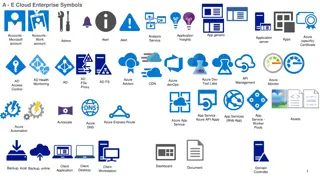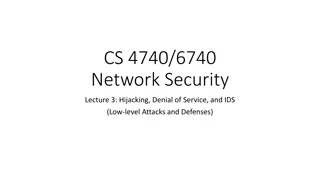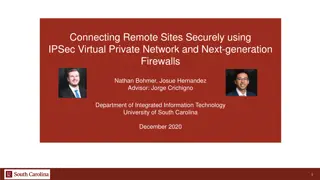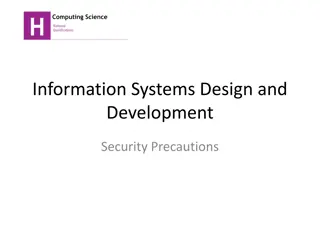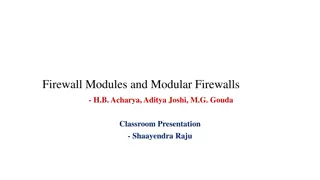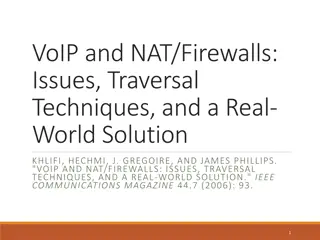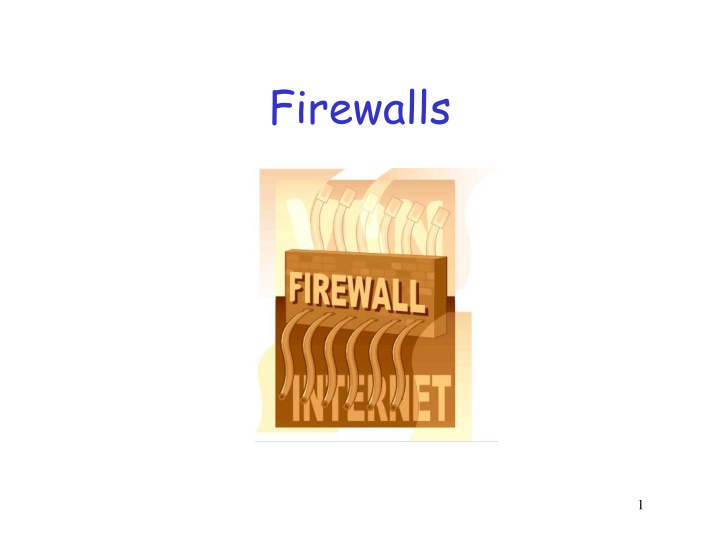
Firewalls in Network Security
Learn why firewalls are essential for protecting organizations from Internet-based threats, how they work to control access, and their key characteristics and terminology. Explore the role of firewalls in establishing a secure perimeter between internal networks and the Internet.
Download Presentation

Please find below an Image/Link to download the presentation.
The content on the website is provided AS IS for your information and personal use only. It may not be sold, licensed, or shared on other websites without obtaining consent from the author. If you encounter any issues during the download, it is possible that the publisher has removed the file from their server.
You are allowed to download the files provided on this website for personal or commercial use, subject to the condition that they are used lawfully. All files are the property of their respective owners.
The content on the website is provided AS IS for your information and personal use only. It may not be sold, licensed, or shared on other websites without obtaining consent from the author.
E N D
Presentation Transcript
The Need for firewalls Internet connectivity is no longer optional for organizations Individual users within the organization want and need Internet access While Internet access provides benefits to the organization, it enables the outside world to reach and interact with local network assets This creates a threat to the organization While it is possible to equip each workstation and server on the premises network with strong security features, this may not be sufficient and in some cases is not cost-effective Firewall An alternative, or at least complement, to host-based security services Is inserted between the premises network and the Internet to establish a controlled link and to erect an outer security wall or perimeter The aim of this perimeter is to protect the premises network from Internet- based attacks and to provide a single choke point where security and auditing can be imposed May be a single computer system or a set of two or more systems that cooperate to perform the firewall function
Firewalls Internal network Internet Firewall Firewall decides what to let in to internal network and/or what to let out Access control for the network 3
Firewall characteristics Design goals for a firewall: All traffic from inside to outside, and vice versa, must pass through the firewall Only authorized traffic, as defined by the local security policy, will be allowed to pass The firewall itself is immune to penetration Techniques that firewalls use to control access and enforce the site s security policy: Service control Determines the types of Internet services that can be accessed, inbound or outbound Direction control Determines the direction in which particular service requests may be initiated and allowed to flow through the firewall User control Controls access to a service according to which user is attempting to access it Behavior control Controls how particular services are used
Firewall Terminology No standard firewall terminology Types of firewalls o Packet filter works at network layer o Stateful packet filter transport layer o Application proxy application layer Other terms often used o e.g., deep packet inspection 5
1. Packet Filter Operates at network layer Can filter based on o Source IP address o Destination IP address o Source Port o Destination Port o Flag bits (SYN, ACK, etc.) o Egress or ingress application transport network link physical 6
1. Packet Filter Advantages? o Speed Disadvantages? o No concept of state o Cannot see TCP connections o Blind to application data application transport network link physical 7
1. Packet Filter Configured via Access Control Lists (ACLs) Flag Bits Source IP Dest IP Source Port Dest Port Action Allow Inside Outside Any 80 Any Allow Outside Inside 80 > 1023 ACK Deny All All All All All Q: Intention? A: Restrict traffic to only Web browsing 8
TCP ACK Scan Attacker scans for open ports thru firewall o Port scanning is first step in many attacks Attacker sends packet with ACK bit set, without prior 3-way handshake o Violates TCP/IP protocol o ACK packet pass thru packet filter firewall o Appears to be part of an ongoing connection o RST sent by recipient of such packet 9
TCP ACK Scan ACK dest port 1207 ACK dest port 1208 ACK dest port 1209 RST Internal Network Trudy Packet Filter Attacker knows port 1209 open thru firewall A stateful packet filter can prevent this o Since scans not part of established connections 10
2. Stateful Packet Filter Adds state to packet filter Operates at transport layer Remembers TCP connections, flag bits, etc. Can even remember UDP packets (e.g., DNS requests) application transport network link physical 11
2. Stateful Packet Filter Advantages? o Can do everything a packet filter can do plus... o Keep track of ongoing connections prevents TCP ACK scan o Some stateful firewalls keep track of TCP sequence numbers prevents session hijacking (see next slides) Disadvantages? o Cannot see application data o Slower than packet filtering application transport network link physical 12
Session Hijacking (Example) TCP is not intended for use as an authentication protocol But IP address in TCP connection often used for authentication Recall: One mode of IPSec relies on IP address for authentication 13
Session Hijacking (Contd) SYN, SEQ a SYN, ACK a+1, SEQ b ACK b+1, data Bob Alice Recall the TCP three way handshake Initial sequence numbers: SEQ a and SEQ b o Supposed to be selected at random If not 14
Session Hijacking (Contd) Bob Trudy 5. 5. 5. Alice 5. 15
Session Hijacking (Contd) Initial SEQ numbers Mac OS X Random SEQ numbers If initial SEQnumbers not very random possible to guess initial SEQnumber and previous attack will succeed 16
Session Hijacking (Contd) Trudy cannot see what Bob sends, but she can send packets to Bob, while posing as Alice Trudy must prevent Alice from receiving Bob s packets (or else connection will terminate) If password (or other authentication) required, this attack fails If TCP connection is relied on for authentication, then attack can succeed Bad idea to rely on TCP for authentication 17
Table 12.2 Example Stateful Firewall Connection State Table [SCAR09b]
3. Application Proxy A proxy is something that acts on your behalf Application proxy looks at incoming application data Verifies that data is safe before letting it in application transport network link physical 19
3. Application Proxy Advantages? o Complete view of connections and applications data o Filter bad data at application layer (viruses, Word macros) Disadvantages? o Speed application transport network link physical 20
3. Application Proxy Creates a new packet before sending it thru to internal network Attacker must talk to proxy and convince it to forward message Proxy has complete view of connection Prevents some scans stateful packet filter cannot next slides 21
Firewalk Tool to scan for open ports thru firewall Attacker knows IP address of firewall and IP address of one system inside firewall o Set TTL to 1 more than number of hops to firewall, and set destination port to N If firewall allows data on port N thru firewall, get time exceeded error message o Otherwise, no response 22
Firewalk and Proxy Firewall Packet filter Router Router Router Trudy Dest port 12343, TTL=4 Dest port 12344, TTL=4 Dest port 12345, TTL=4 Time exceeded This will not work thru an application proxy (why?) The proxy creates a new packet, destroys old TTL 23
Host-Based Firewall A software module used to secure an individual host Is available in many operating systems or can be provided as an add-on package Filters and restricts the flow of packets Common location is a server Advantages: Filtering rules can be tailored to the host environment Protection is provided independent of topology Used in conjunction with stand-alone firewalls, provides an additional layer of protection
Personal Firewall Controls the traffic between a personal computer or workstation on one side and the Internet or enterprise network on the other side Can be used in the home environment and on corporate intranets Typically is a software module on the personal computer Can also be housed in a router that connects all of the home computers to a DSL, cable modem, or other Internet interface Primary role is to deny unauthorized remote access to the computer Can also monitor outgoing activity in an attempt to detect and block worms and other malware
Figure 12.2 Example Personal Firewall Interface
Firewalls and Defense in Depth Typical network security architecture DMZ FTP server Web server DNS server Intranet with additional defense Packet Filter Application Proxy Internet 28



